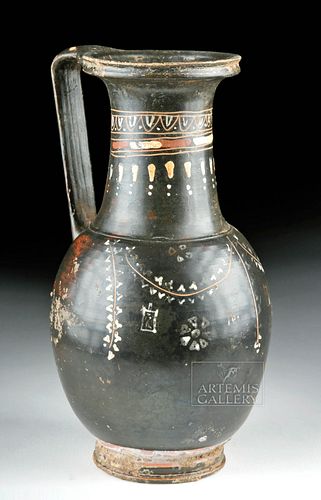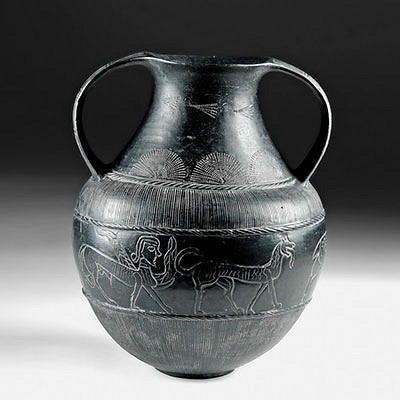Greek Apulian Gnathian Blackware Olpe - Maker's Mark
Lot 20a
About Seller
Artemis Fine Arts
686 S Taylor Ave, Ste 106
Louisville, CO 80027
United States
Selling antiquities, ancient and ethnographic art online since 1993, Artemis Gallery specializes in Classical Antiquities (Egyptian, Greek, Roman, Near Eastern), Asian, Pre-Columbian, African / Tribal / Oceanographic art. Our extensive inventory includes pottery, stone, metal, wood, glass and textil...Read more
Categories
Estimate:
$1,200 - $1,800
Absentee vs Live bid
Two ways to bid:
- Leave a max absentee bid and the platform will bid on your behalf up to your maximum bid during the live auction.
- Bid live during the auction and your bids will be submitted real-time to the auctioneer.
Bid Increments
| Price | Bid Increment |
|---|---|
| $0 | $25 |
| $300 | $50 |
| $1,000 | $100 |
| $2,000 | $250 |
| $5,000 | $500 |
| $10,000 | $1,000 |
| $20,000 | $2,500 |
| $50,000 | $5,000 |
| $100,000 | $10,000 |
| $200,000 | $20,000 |
About Auction
By Artemis Fine Arts
Sep 17, 2020
Set Reminder
2020-09-17 10:00:00
2020-09-17 10:00:00
America/New_York
Bidsquare
Bidsquare : CLEARANCE - Ancient, Pre-Columbian, Ethno Art
https://www.bidsquare.com/auctions/artemis-gallery/clearance---ancient-pre-columbian-ethno-art-5605
End-of-Summer Clearance sale featuring discounted pricing on antiquities from Egypt, Greece, Italy, and the Near East...plus Viking, Asian, Pre-Columbian, Tribal, Russian Icons, Spanish Colonial, Fine Art, more! Starting prices have been reduced up to 65% from original auction prices. Artemis Fine Arts info@artemisfinearts.com
End-of-Summer Clearance sale featuring discounted pricing on antiquities from Egypt, Greece, Italy, and the Near East...plus Viking, Asian, Pre-Columbian, Tribal, Russian Icons, Spanish Colonial, Fine Art, more! Starting prices have been reduced up to 65% from original auction prices. Artemis Fine Arts info@artemisfinearts.com
- Lot Description
**Originally Listed At $1000**
Magna Graecia, southern Italy, Apulia, Gnathian, ca. 325 BCE. A beautiful example of the funerary pottery made in southern Italy when it was part of the Greek colonial sphere. A lovely olpe, with an ovoid bulbous body rising to a tubular neck that flares to a collared rim with a strap handle joining rim to shoulder - all upon a tiered foot with a maker's mark on the base in the form of a large red cross. This is an example of Gnathian ware, distinguished by its colorful decoration - budded garlands and stylized floral motifs adorning the body, and decorative registers on the neck featuring from top to bottom: an egg and dart motif, repeated lozenge-shaped 'beads', and dotted strokes - all in fugitive red, white, and yellow pigments applied directly to a lustrous black glaze. Size: 7.75" H (19.7 cm)
Gnathia ware is named for the site where it was first discovered - the Apulian site of Egnathia (also Gnatia, Egnatia, Ignazia). The black glaze ware is traditionally decorated with floral and other decorative motifs in red, white, and/or yellow hues. Scholars believe that its production most likely was centered around Taras, with primary workshops in Egnathia and Canosa. The quantity and quality of Greek colonial Apulian potters increased significantly following the Peloponnesian War when Attic exports dramatically decreased. Apulian artistry demonstrates influences of Ionian (Athenian, Attic) conventions, as well as Doric (western colonial Greek) styles, with a palpable native Italian aesthetic.
Provenance: private East Coast, USA collection; ex-Frances Artuner collection, Belgium, acquired in the 1960s
All items legal to buy/sell under U.S. Statute covering cultural patrimony Code 2600, CHAPTER 14, and are guaranteed to be as described or your money back.
A Certificate of Authenticity will accompany all winning bids.
We ship worldwide and handle all shipping in-house for your convenience.
#144086Normal surface wear with scuffs and some pigment loss as shown. Areas of encrustation on the body and base as shown. Otherwise intact and quite lovely.Condition
- Shipping Info
-
All shipping is handled in-house for your convenience. Your invoice from Artemis Gallery will include shipping calculation instructions. If in doubt, please inquire BEFORE bidding for estimated shipping costs for individual items.
-
- Buyer's Premium



 EUR
EUR CAD
CAD AUD
AUD GBP
GBP MXN
MXN HKD
HKD CNY
CNY MYR
MYR SEK
SEK SGD
SGD CHF
CHF THB
THB
















